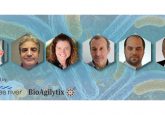Flow cytometry in mouse model development: an interview with Christoph Eberle and Steve Festin

Christoph Eberle was trained in biochemistry at the University of Bayreuth (Bavaria, Germany), where he graduated with a bachelor’s and master’s degree. Subsequently, he moved onto the University of Bremen (Germany) for a PhD in organic chemistry under the tutelage of Professor Franz-Peter Montforts, synthesizing novel porphyrin and porphyrin-fullerene derivatives for immobilization on gold surfaces. Funded by the German Academic Exchange Service (DAAD), he spent 3 months as a visiting scientist in the laboratories of Professor Luisa Maria Abrantes at the University of Lisbon (Portugal) to characterize the electrocatalytic and sensing properties of his compounds.
Following postdoctoral research at Dartmouth College (NH, USA), he began his career in laboratory medicine at the University Medical Center Göttingen (Lower Saxony, Germany). He later transitioned into private industry, holding lead scientific positions at the Eurofins Central Laboratory (Washington, DC and Lancaster, PA, USA) and Envigo (Somerset, NJ, USA), where he focused on fit-for-purpose validation of multiple cell-based assay formats, preclinical and clinical trial sample testing and reporting. Dr Eberle joined Charles River as a Principal Scientist at the Worcester site (MA, USA) in 2017 to provide immunology testing expertise in support of the company’s integrated oncology drug discovery services. As a member of the local pharmacology team, he oversees assay development and ex-vivo analysis using flow cytometry. He is a member of various professional societies dedicated to flow cytometry, clinical diagnostics and research, including the International Society of Advancement of Cytometry (ISAC), the Institute of Clinical Research (ICR) and the American Association of Clinical Chemistry (AACC). In 2013 he was elected an Associate Fellow of the AACC Academy, formerly the National Academy of Clinical Biochemistry (NACB) and received a Clinical Chemist’s Recognition Award in 2014. This year, he also became a Fellow of the Royal Society for Public Health (RSPH) in the United Kingdom.
Stephen Festin is currently Director of Scientific and Commercial Development at Charles River Laboratories. He is responsible for strategic scientific initiatives to improve research tools in biomedical research with emphasis in novel xenogenic research models, microbiome and genetics. Previously, he has served as Vice President of Research at Pulmokine (NY, USA), a start-up pharmaceutical development company focused on inhalation therapies for pulmonary disease, Principal Scientist at BioReliance (Sigma-Aldrich; MD, USA), Director at TDMI (MD, USA) a surgical contract research organization and Taconic (NY, USA) as Head of R&D and Director of Scientific Services. He has 30 years of experience in scientific research and management in academic, pharmaceutical, biotechnology and government organizations. Steve earned a Bachelor of Science degree in Chemistry from Villanova University (PA, USA), completed PhD studies in Biochemistry and Molecular Biology at Albany Medical College (NY, USA), a post-doctoral fellowship at the National Cancer Institute (MD, USA) and Assistant Professorship in Biology/Biochemistry at Hamilton College (NY, USA). Dr Festin has published multiple scientific articles, given lectures and presentations in cancer research, oncology research models, peptide/protein chemistry, molecular diagnostics, microbiome, genomics, bioinformatics and laboratory management. He managed corporate R&D, US and EU laboratory operations, business development, strategic planning and education initiatives. He has led subcommittees of scientific societies including The Endocrine Society and The American Association for Cancer Research and a number of regional scientific and business interest groups. Steve is also an active member of the National Ski Patrol and US Rowing organizations.
♦ = Christoph Eberle | ♦ = Steve Festin
1Please introduce yourself and explain what began your interest in flow cytometry?
My name is Christoph Eberle, and I am a Principal Scientist at Charles River Laboratories at its discovery site in Worcester, Massachusetts. Since joining Charles River in 2017, we have added flow cytometry as a pharmacodynamic readout to the studies conducted by our local in vivo pharmacology group. Being part of that group, I am particularly aware of client interests in the ex vivo capabilities we now offer, and for many of our clients, immunology testing expertise is one of the major considerations in partnering with Charles River.
Originally, I trained as a biochemist, and later did research in synthetic chemistry, graduating with a PhD in Organic Chemistry from the University of Bremen, Germany. My original interest in flow cytometry developed 10 years ago when working at the University Medical Centre in Göttingen, Lower Saxony, Germany. In their department of clinical chemistry, I focused on evaluating cellular biomarkers of acute rejection in transplant patients to identify those that are tolerant and prevent those that are losing tolerance from graft loss and death by balancing an immunosuppressant therapy. Meanwhile, the search for potentially more predictive markers continues as we better measure underline processes including the immunological ones. Previously, I was fortunate to work under the mentorship of Professor Michael Oellerich, a widely recognized expert in therapeutic drug monitoring, and since then I have specialized in cell-based assay development, qualification and validation using flow cytometry. I have now utilized this technology in most of the drug development stages, from early discovery to clinical Phase II trials.
2Could you introduce yourself and explain what began your interest in mouse model research?
My name is Steve Festin, and I am a Director of Scientific and Commercial Development for Charles River in the research models and services (RMS) business. The RMS business is focused on research models, and the mouse model research I am involved in began when I started at Charles River 5 years ago. I have been personally interested in mouse model research for over 30 years, beginning in graduate school working with mouse models of oncology. I’ve spent much of the time since then working with in vivo models in a variety of different settings including my first academic research lab and as a Postdoc at NIH (MD, USA). Since that time, I’ve been working for 15 years in research model scientific and commercial development.
Flow cytometry is not just useful but critical for the characterization of mouse models, especially those associated with immunodeficienct phenotypes. In particular, for humanized mouse models, flow cytometry is the cornerstone of our capability to analyze and characterize immune cell populations. The technology allows us to look at cells that are absent in immunodeficient mouse models. We transfer human cells into the mouse recreating human immune components that can be useful in the study of several different areas. An example of this is in oncology – which has been a focus throughout my career – investigating the interplay between the human immune system and human tumors that grow in these oncology mouse models. Humanized models are also used for infectious disease research as well in the study of various other conditions including graft versus host disease and autoimmunity. For us, to be able to develop and provide the highest quality of research model, flow cytometry is absolutely critical. It is our window to understand and measure the quality of models that we intend to produce for the research community.
3What are the challenges you face when developing mouse models?
In any in vivo model there are a number of challenges that one faces. These are live systems which enable the study of human disease in the context of the natural physiology of living systems. Within the mouse models themselves, there are many challenges we face the first of which is limiting the number of possible interfering factors. In research or laboratory animals there is a focus on ensuring that the animals are both healthy and free of endogenous pathogens. This is an important property because it enables us to distribute and/or share models with laboratories all over the world.
Another challenge, from a genetic standpoint, is that we work with different types of mouse models. These may be either inbred or outbred models. Maintaining the genetic composition of the models is a critical factor – we spend a great deal of time and effort conducting molecular PCR analysis on these models to ensure that we have the expected genetic makeup going forward. However, even with these efforts to ensure consistency within the mouse model they still perform like any other in vivo system in that they can be somewhat unpredictable when running the studies. It’s very important to have tools like FACS analysis, the ability to evaluate individual animals. The primary difference between using flow cytometry, along with assessing genetics and animal health testing is that flow cytometry looks at the phenotype or cellular physiology of each individual model. This is critical for us to understand the performance of the model throughout the study.
4How does Charles River’s portfolio of research model services help to overcome these challenges?
We’re continually working to both expand and improve our research model portfolio. This involves working very closely with our customers, including academic scientists, pharmaceutical companies and the biotech sector. We constantly monitor the different disease research focus areas for new model opportunities. We seek out and attempt to expand our portfolio on a continual basis so that we may enable researchers to conduct necessary studies by providing them with models of interest. There are a few different ways we go about doing this, for example with our humanized mouse models, we’re working with an immunodeficient mouse. Using this mouse, we are able to transfer human immune cells creating a hybrid model of a mouse with components of a human system. This enables studies in immuno-oncology looking at the interplay of the immune system and tumors.
In addition to these efforts, Charles River RMS and GEMS offers services in model creation and genetic engineering of mouse models to customize genetic modifications at the request of our clients. A key partner for us is Christoph, and the team at Charles River’s Worcester site as well as our other discovery and safety sites across the world. We work very closely with them to help support the studies, developing and providing necessary models to enable the client research. Their expertise in the in vivo applications in the study of disease and therapeutics drive us to the highest quality research models and enable us to keep our portfolio current.
5How do you apply flow cytometry to support mouse model development?
Internally, at Charles River, we are screening new humanized NCG mice using flow cytometry. In an ongoing panel project, we phenotype specimen collected from mice that were engrafted with different sources of human CD34 positive stem cells. With data from our staining panels, over time, we evaluate humanization levels in blood, distribution of leukocyte subsets in various tissues such as liver, lung and lymph nodes, and the performance of our humanized mouse models in pilot tumor growth studies. Here we assess the immune microenvironments by flow cytometry under various standard treatments at study termination – the aim being that these data can stand compared to our previous ones using other mouse models and compared to data from mouse models offered by other commercial breeders. Flow cytometry confirms humanization as a quality control whilst the phenotype characterization beyond that guides product improvement as our final product may offer a better research model than our competitors.
For now, this type of research in our field still relies on research models to study the effect of immunomodulatory agents on tumor growth. Generally, researchers hope to trigger leukocyte inflammation into the tumors and stop T-cells in the microenvironment from becoming exhausted – all of this, without causing potentially severe immune-mediated side effects. Everyone in the field faces the same challenge, which is to have the best possible model that can predict drug efficacy in the clinic. So, the better experimental results gained from such models can translate to what can be expected in patients, the less animal studies may be necessary when developing a new drug.
6What major question do you attempt to answer using the flow cytometry assays developed for this type of research?
Ultimately, we would like to offer more robust, less expensive, humanized mice that maintain good health and do not develop graft versus host disease prior to being included in research experiments. Whether transplantation was successful and can be maintained are the two questions to answer which determine the success of model performance. Accordingly, for each batch we need to know firstly whether individual animals are indeed humanized as defined by the frequency of human CD45 positive leukocytes and the absence of murine CD45 positive cells in the periphery, and secondly, whether typical levels of populating human lymphoid and myeloid subsets can be found.
It would fulfil expectations if the mice we are developing can give human immunity in the presence of tumor xenografts throughout their lifetime. That means, at least for those in duration of a typical in life pharmacology study which can last up to 3–4 weeks. Only then, these preclinical models are useful for accessing exploratory cancer immunotherapies. Among those working with animal models of disease there is still some skepticism towards humanized mice currently available given their extremely high cost and fragility. We at Charles River hope to dispel these doubts by demonstrating that in purebred mice we can consistently reconstitute the human immune system with all its compartments, its functionality and interdependency.
7Where do you hope this field will be in 5–10 years’ time?
Christoph: Flow cytometry is one of the key analytical technologies in present day immuno-oncology research. Standardizing experiments that utilize this technology is increasingly required by end users and by regulatory agencies. In the end, if you look at its core it is a sophisticated, fast paced enumeration machine, and anything that makes this cell by cell enumeration more precise will always be crucial. To me, however, improving what happens before the cytometrics will be even more important. The way in which suspension cell samples are prepared impacts the reproducibility and repeatability of such measurements. In our laboratory, we collaborated with an industrial partner to explore options to standardize wash steps in common staining protocols, and with that we hope to see promising improvements to our entire workflow. These improvements could particularly benefit flow cytometric analyses that demand consistency for longitudinal studies while maximizing the signal to noise ratio. Therefore, going forward automation of immunophenotyping protocol will hopefully make a huge difference in every laboratory that produces flow cytometry data irrespective of what they are used for. In our line of research work, such efforts could support generating better and potentially more meaningful datasets on tumor infiltrating immune cells that help to decide on exploratory cancer therapeutics.
Steve: What we, or what I, do is try to anticipate the future directions of research and provide access to research models that our clients and partners at Charles River are going to need. There are some clear directions that are assisted by our ability to study cells very closely using flow cytometry and analyze them as well as various other techniques and capabilities that allow us to continue to develop and generate research models. Within 5–10 years we expect to continue to expand our in vivo portfolio, and are very interested in other interactions associated with research models including topics like the microbiome. I also think that some of the future perspective here would be more in vivo like systems, where it’s a sort of hybrid between in vivo and in vitro. I think flow cytometry will be a key factor here as well in the study and ability to analyze different cell types, to enable expansions of the capability for drug development as well as basic research.



